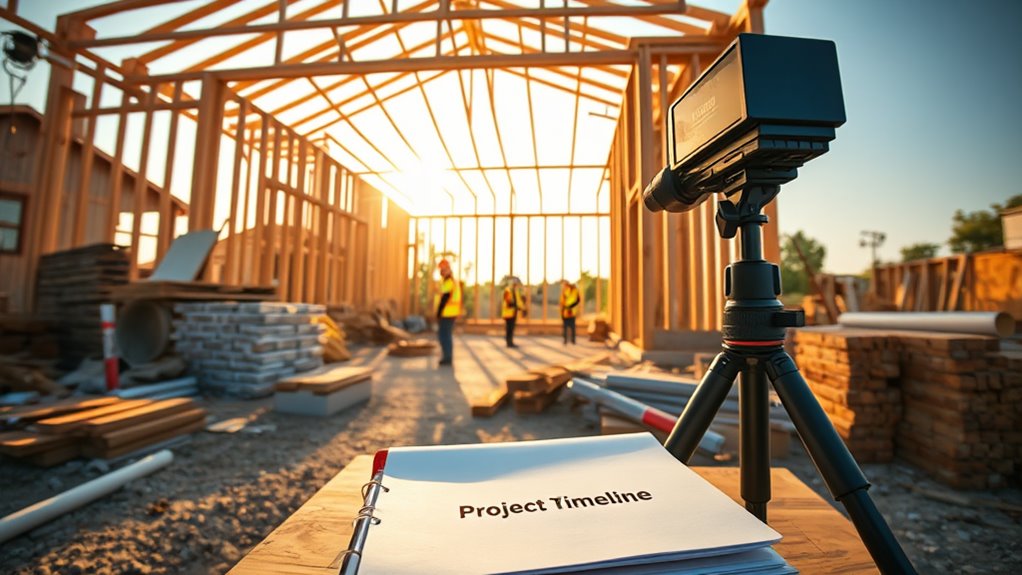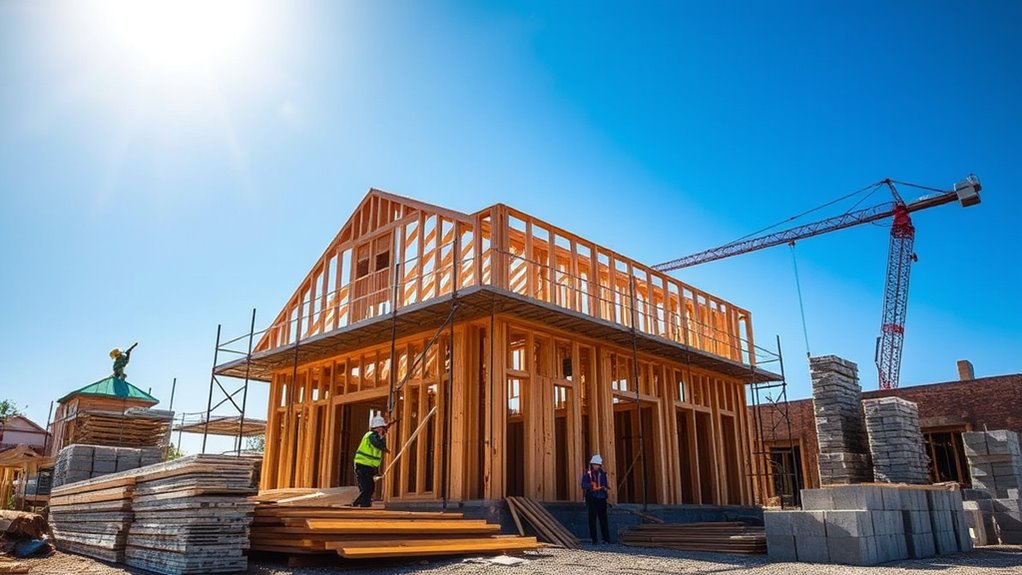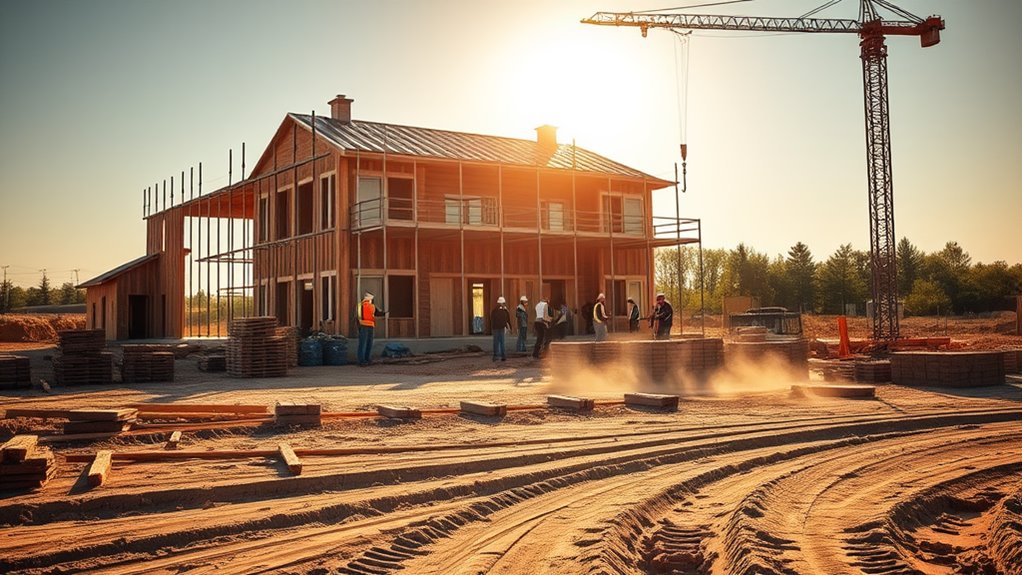On average, building a house takes about 8.6 months in the U.S., but timelines can vary. Production homes often finish in 4-6 months, while custom builds may take 10-16 months. Key phases like site prep, framing, and interior finishes each span weeks or months. Weather, permits, and design changes can delay progress, especially in regions like the Northeast. Understanding these factors helps you plan better and set realistic expectations for your project’s completion.
Key Takeaways
- U.S. home construction averages 8.6 months, with custom builds taking 10-16 months.
- Regional differences exist; Northeast takes 11.1 months, South completes in 6.1 months.
- Key phases include site prep (1-3 weeks), framing (2-6 weeks), and interior finishes (1-2 months).
- Weather, permitting delays, and material shortages can extend timelines significantly.
- To minimize delays, finalize designs early, stick to budgets, and secure pre-construction approvals.
Average Timeframe for Building a House
While building a house can vary widely based on factors like design, location, and construction method, the average timeframe in the U.S. is about 8.6 months, according to the 2023 U.S. Census Bureau report. Production homes, which use standardized designs, often have the fastest construction timeline, averaging 4 to 6 months. Contractor-built homes typically take around 9 months, while owner-built homes, which involve more hands-on management, average closer to 12 months. Custom homes, with their unique designs and complexity, can extend the completion time to 10 to 16 months. Regional differences also play a significant role; southern regions average 6.1 months, while the Northeast takes about 11.1 months. Delays in home construction can arise from weather, permitting, or material shortages, but understanding these variables helps you better plan your project. Whether you’re opting for custom homes or production homes, knowing the average time to build guarantees you set realistic expectations.
Key Phases of Home Construction
Understanding the average timeframe for building a house helps set expectations, but breaking the process into its key phases can offer more clarity. Home construction typically begins with site preparation, where you’ll clear the land and conduct inspections, taking 1-3 weeks. Next, foundation laying involves excavation and concrete work, lasting 1-4 weeks depending on complexity. Framing follows, creating the structural framework and roof, which usually spans 2-6 weeks. After framing, you’ll install major systems like HVAC, plumbing, and electrical, a phase that generally takes 1-2 months. Finally, interior finishes bring the house to life with flooring, paint, and fixtures, adding another 1-2 months. Each phase has its own timeline, and delays in one can affect the overall construction process. By understanding these key phases, you’ll better manage the average completion time and guarantee a more organized home-building experience.
Factors Affecting Construction Timelines

The timeline for building a house can vary depending on several key factors that you’ll need to plan around. Custom homes typically take longer to complete than production homes due to their complexity and unique design plans. Weather conditions can also greatly impact construction phases, especially during winter or rainy seasons, causing project delays. The permitting process is another variable—inefficiencies or strict local regulations can extend the time it takes to get approvals. Material shortages or labor unavailability, particularly during peak seasons, can stall progress and lead to construction delays. Additionally, any changes to design plans mid-construction, such as last-minute customizations, can disrupt schedules and prolong the build. To manage these factors effectively, you’ll need to anticipate potential setbacks, maintain clear communication, and allocate buffer time in your schedule. Proper planning minimizes unexpected issues, ensuring a smoother process for building a house.
Regional Differences in Build Time
If you’re planning to build a house, it’s important to contemplate how regional differences can greatly impact construction timelines. The average build time varies considerably across the U.S., influenced by construction processes, environmental factors, and resource availability.
- The Northeast region has the longest average build time at 11.1 months due to harsh winters and complex regulations.
- The South region completes homes fastest, averaging 6.1 months, thanks to mild weather and efficient workflows.
- The Midwest region averages 7.7 months, balancing urban and rural construction practices, while the West region hovers around 7.1 months, affected by material availability and environmental concerns.
Metropolitan areas typically see shorter timelines compared to rural regions, where access to labor and materials can slow progress. Understanding these regional differences helps you better manage your home construction timeline, ensuring you account for location-specific challenges.
Tips to Minimize Construction Delays

Regional differences in build time highlight the importance of managing your construction timeline effectively. To avoid delays, start by collaborating with your architect and builder to develop realistic plans that account for potential factors. Stick to your budget to prevent overspending, which could derail the project. Minimize change orders by finalizing your design and selections early, as adjustments often complicate timelines. Opt for standard floor plans and features that builders and subcontractors are familiar with, as this reduces learning curves and keeps the process on track. Carefully research and interview multiple contractors to select a competent builder with a proven track record of adhering to timelines. Ascertain all necessary approvals are secured before breaking ground to prevent holdups. By addressing these factors proactively, you’ll streamline your home construction and maintain control over the project’s progress.
Conclusion
Building a house can feel like an eternity if you’re not meticulous with planning. If you nail the timelines—from permits to final inspections—you could finish in six months, but procrastinate on decisions, and you might as well pack for a decade-long expedition. Stay laser-focused, anticipate delays like they’re lurking around every corner, and communicate like your dream home depends on it. Time’s ticking, and every second wasted is another night in your in-laws’ basement.




